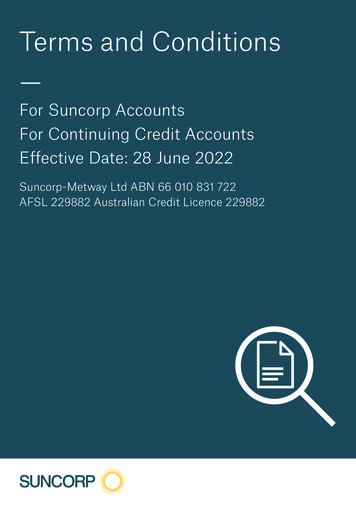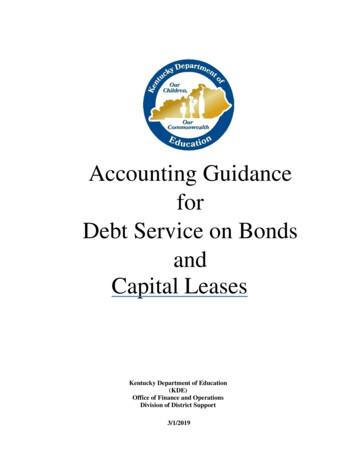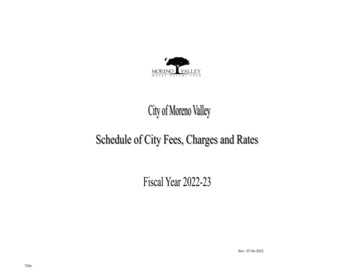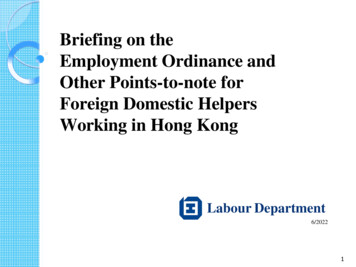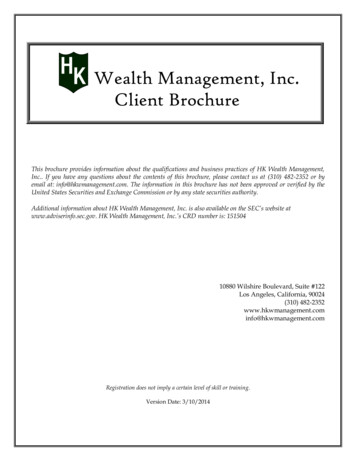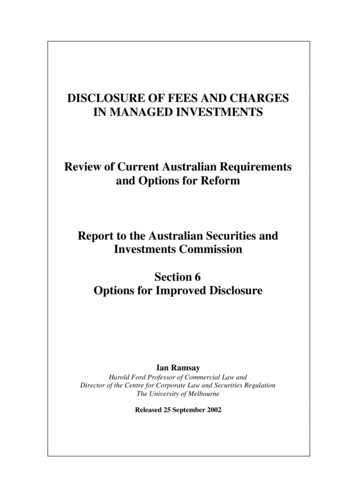
Transcription
DISCLOSURE OF FEES AND CHARGESIN MANAGED INVESTMENTSReview of Current Australian Requirementsand Options for ReformReport to the Australian Securities andInvestments CommissionSection 6Options for Improved DisclosureIan RamsayHarold Ford Professor of Commercial Law andDirector of the Centre for Corporate Law and Securities RegulationThe University of MelbourneReleased 25 September 2002
Australian Securities and Investments Commission 2002ISBN 0 7340 2904 7This publication may be freely reproduced provided suitable acknowledgment ismade.Research and writing of this report was completed at 31 July 2002.Copies of the full report are available on the Australian Securities and InvestmentsCommission website at: http://www.asic.gov.au
194Part 6Options for Improved DisclosureINTRODUCTIONIn this section of the report options for improved disclosure of fees and charges inmanaged investments are proposed for the consideration of ASIC and industry.It is worth recalling the Good Disclosure Principles from Policy Statement 168. ThesePrinciples were outlined in Part 2 of the report. According to the Principles, disclosureshould: be timely; be relevant and complete; promote product understanding; promote comparison; highlight important information; and have regard to consumers’ needs.It has been said that the key purposes of disclosure standards in the area of fees andcharges are to ensure that:282 fees and commissions are transparent and readily understood by the averageinvestor; investors have an understanding of the cost of entering into any contract; investors know the amount and timing of any remuneration to be received bythe adviser from any investment decision; any investment decision is unbiased by the level of remuneration received bythe adviser; and282Phillips Fox, Financial Services Reform Act: Product Disclosure of Fees, Charges and Commissions,Report Prepared for ASIC, November 2000, p 5.
195 investors can compare the cost of making an investment against alternateproducts in the marketplace.As noted in Part 3 of this report, I believe there is a need for improved disclosure offees and charges in relation to managed investments. This was a common themerunning through many of the meetings with key stakeholders although not allstakeholders agreed in relation to the degree of improvement needed and what shouldbe done to improve disclosure.Part 3 of the report identifies a number of problems with existing disclosure of fees andcharges.In that Part the results were presented of surveys of the adequacy ofdisclosure of fees and charges in prospectuses.These surveys showed there isconsiderable scope for the improvement of disclosure of fees and charges inprospectuses.This conclusion was reinforced by an examination of surveys, theresults of which were summarised in Part 3, which have tested investors’understanding of fees and charges. The results of these surveys show that a significantnumber of investors fail to understand basic information about fees and charges.Part 6 of the report contains the following sections: options for improved disclosure in Product Disclosure Statements (PDSs); options for improved disclosure in periodic member statements; and options for implementation and the role of ASIC and industry.OPTIONS FOR IMPROVED DISCLOSURE IN PDSSThere are a number of issues that warrant consideration in relation to options forimproved disclosure in PDSs. The issues discussed in this section are: standardised descriptions and definitions of fees; to what extent should fees be broken down?; entry/contribution fees; exit/withdrawal fees; capacity to increase fees/maximum fees;
196 ongoing management charge/management expense ratio; showing the effect of fees on returns; disclosure in dollars versus disclosure in percentages; disclosure of fees paid to advisers; the buy/sell spread; disclosure of fees near returns; and disclosure of ability to negotiate rebates with advisers.STANDARDISED DESCRIPTIONS AND DEFINITONS OF FEESIn Policy Statement 168, ASIC states that an example of a disclosure issue that maybenefit from clarification, particularly if greater comparability of products is to beachieved, is “standardised description of like fees and charges (such as commissions),including the basis for showing the future impact of fees and charges”.It is clear from a perusal of existing prospectuses (see Part 3 of this report) that muchmore can be done to standardise descriptions and definitions of fees. The same feesare sometimes given different descriptions. Key stakeholders consulted as part of thisproject were generally supportive of more standardised descriptions of fees.Inaddition, relevant fees are not always disclosed in the section which deals with fees.For example, it is sometimes the case that switching fees are discussed not in the feessection of the prospectus but in another section. A potential investor therefore has toperuse all of the prospectus to identify whether fees may or may not apply.Particular types of fees are discussed below. However, as a matter of principle, I seeconsiderable merit in the following principles being adopted by those who preparePDSs: All relevant fees are to be referred to in the fees section of the PDS (in somecircumstances it might be appropriate for more detailed discussion of particularfees to be located elsewhere in the PDS provided there is an appropriate crossreference from the fees section of the PDS where the fee is identified to the moredetailed discussion elsewhere in the PDS).
197 Even if a fee which is commonly imposed is not imposed in relation to aparticular product, the fact that this fee is not imposed should be disclosed in thefees section of the PDS. For example, if a particular product does not have anentry fee, exit fee or switching fees applying to it, then this should be stated inthe fees section of the PDS. This has the advantage of enhancing comparabilityof PDSs and eliminates the need on the part of a potential investor to search theentire PDS to identify whether a fee is imposed. The purpose of any fee which is imposed should be disclosed in the fees sectionof the PDS. To the maximum extent possible, there should be standardised descriptions anddefinitions of fees (specific fees are discussed below). Consideration should be given to a standardised table across all PDSs forfinancial products which would identify significant fees (such as entry, exit,switching and investment management fees), state whether or not each feeapplies to the particular product and, if so, state the amount of the fee.There can be a higher degree of complexity of fees in relation to superannuation thansome other financial products. However, it is still possible to have a table whichidentifies whether or not significant fees are applicable and, if so, the amount of thefees. Such a table in relation to a superannuation product could include the following:Type of FeeAmount(state Nil if not applicable)Establishment feeContribution feeAdministration feeInvestment management feeSwitching feeWithdrawal feeThe table can also be used for non-superannuation products (although the reference toestablishment fee may need to be removed). This, or a similar type of table, would belocated in the fees section of the PDS. In the same section of the PDS there would be adescription of each of the relevant fees and also a statement about the purpose whyeach fee is imposed.
198I now turn to discuss the extent to which fees should be broken down in a PDS and,following this, I discuss specific types of fees.TO WHAT EXTENT SHOULD FEES BE BROKEN DOWN?There is debate concerning the extent to which fees should be broken down anddisclosed in PDSs. At one end of the spectrum, there is an argument that if it ispossible to come up with a single global figure which captures all fees, then this hasstrong advantages for potential investors in terms of simplicity and enhancingcomparability of PDSs. At the other end of the spectrum, there is the argument thatseparate disclosure of all applicable fees means that potential investors have allinformation in order to make an investment decision.Both of these positions have difficulties and disadvantages associated with them. Tocome up with a single global figure which captures all fees may be impossible to do inany meaningful way. Some types of fees may be fixed dollar fees imposed each monthor year. An administration fee in a superannuation fund is often this type of fixeddollar fee. Other types of fees are typically fixed percentage fees of certain amounts,such as the amount invested or the amount in the fund. To combine a fixed dollar feeand a percentage fee in a meaningful way is difficult and requires additionalcalculations.A more significant difficulty with endeavouring to have a single global figure is thatsome fees are mandatory while others are discretionary. For example, a fund mayimpose switching fees. However, this fee will of course only apply to those investorswho actually switch their investment. This means that a fee which is discretionaryneeds to be disclosed separately from those fees which are mandatory otherwise thesingle global figure has the potential to be very misleading. A similar point can bemade in relation to exit fees. Entry fees may also be discretionary to the extent towhich some investors may pay the full entry fee relevant to a financial product whileothers may have all or part of the entry fee rebated to them. In other words, disclosureof a single global figure which captures all fees may have initial attractions yet it canquickly be seen that a number of important fees would need to be disclosed separately.
199I also note that of those countries whose disclosure requirements were reviewed for thepurposes of this project, none had a single global figure which captures all fees (seePart 5 of this report).In relation to whether or not all fees relating to a financial product should be disclosedseparately in the PDS, the question is whether this can lead to an excess of informationbeing disclosed to investors. For example, a manager of a fund may pay one or morecustodian fees, typically of a small amount when compared to other fees. These feesare usually not disclosed and it is understandable why they are not as it would beunusual for these fees to impact upon the investment decision of a potential investor.There is an important point in relation to the breakdown of fees between administrationand investment management. I see considerable merit in requiring these fees to bedisclosed separately. The reasons for this are as follows. First, they are differentfunctions. Second, separate disclosure of both administration and investment feesenables investors to compare how efficient each of these aspects is across a variety offinancial products. Third, it is typically the case that investment management fees arethe largest ongoing fees. It is important that the fee which is most directly related tothe performance of the fund be separately disclosed. Finally, the distinction betweenadministration and investment has become more important with the growth of masterfunds and IDPSs.I now turn to discuss specific fees.ENTRY/CONTRIBUTION FEESAs stated above, there is merit in moving to more standardised descriptions anddefinitions of fees. A fee which is paid to invest in a particular financial product mayhave different names. The review of prospectuses (summarised in Part 3 of this report)reveals that this fee can be called an entry fee, a contribution fee or a deposit fee.References to it being a deposit fee are rare. Usually, it is called a contribution fee inrelation to superannuation products and an entry fee in relation to managed funds.I see merit in seeing if it is possible to adopt common terminology for this fee acrosssuperannuation and managed funds. This would fit with the Financial Services Reform
200Act objective of enhancing comparability of financial products. The challenge is thatboth of the terms are well entrenched in the marketplace. It might be possible tointerpret the term entry fee as implying that it is a one-off payment (ie paid only whenan investor first invests or “enters”). In fact, it is common for these fees to be paid onfurther investments in the same fund by the same investor although a reduced feemight be applicable. In these circumstances, the term contribution fee would seem tobe more accurate. A contribution fee can be paid when one first invests and can alsobe paid in relation to subsequent investments or contributions. In summary, I see meritin determining whether the term contribution fee can be used across bothsuperannuation and managed funds.As noted above, even if a particular financial product does not have acontribution/entry fee, then this fact should be disclosed in the fees section of the PDS– as part of the fee disclosure table recommended above.I recommend that the purpose of fees which are imposed be disclosed in the PDS. Inrelation contribution/entry fees, if this fee is to be used for adviser remuneration, thenit is appropriate that this purpose be disclosed. After all, this fee can constitute asubstantial percentage of an initial investment.EXIT/WITHDRAWAL FEESA similar issue in relation to terminology arises with this fee as with entry/contributionfees. An exit fee can also be called a withdrawal fee. I make recommendations inrelation to this fee that are similar to my recommendations relating toentry/contribution fees. In particular: there is merit in having common terminology across both superannuation andmanaged funds to enhance comparability; it may be that the term withdrawal fee is more accurate than exit fee as areference to exit fee may imply that one is entirely withdrawing an investmentfrom a fund whereas a fee would still be payable for only a partial withdrawal; if no exit/withdrawal fee is applicable, this should be clearly stated as part ofthe fee disclosure table recommended above; and
201 if an exit/withdrawal fee is payable, then the purpose of this fee should bedisclosed.CAPACITY TO INCREASE FEES/MAXIMUM FEESI recommend that the capacity to increase fees and the maximum fees applicable bedisclosed in the fees section of the PDS. Key stakeholders consulted as part of thisproject were generally supportive of this position. Given that fees can typically beincreased (perhaps substantially) without the approval of investors it is important thatinvestors be aware of this capacity to increase fees. It becomes even more important ifa particular financial product has significant exit/withdrawal fees. If the capacity toincrease fees and the maximum amount to which they can be increased is notdisclosed, then an investor can be severely disadvantaged if fees are increased and aninvestor who wishes to withdraw is then subject to a high exit fee.In summary, where fees which are disclosed in the PDS can be increased this factshould be specifically stated in the fees section of the PDS and the maximum amountto which the fees can be increased should also be disclosed in this section.ONGOING MANAGEMENT CHARGE/MANAGEMENT EXPENSE RATIOThis section discusses the ongoing management charge (“OMC”) and the managementexpense ratio (“MER”). It provides an overview of the OMC/MER and then makesseveral recommendations for improved disclosure.Overview of OMC/MERThe OMC and MER are broadly similar, although they do have differences. In thecase of the MER, the Investment and Financial Services Association (“IFSA”) haspublished IFSA Standard No 4.00 which specifies the principles to be adopted by itsmembers when calculating MERs. IFSA Standard No 4.00 is an Appendix to this partof the report.Paragraph 6.1 of Standard No 4.00 states that the purpose of the Standard is to: specify the principles to be adopted when calculating MERs;
202 provide guidance in the interpretation and application of those principles; and specify the manner in which MERs are disclosed in offer documents and otherreports to investors.In relation to the purpose of MERs, paragraph 6.3 of Standard No 4.00 states:The MER is to capture expenses, which are incurred by the operation of an unlistedScheme. Expenses, which would be incurred by a direct investor in the same assets,should be excluded where these can be identified and isolated. The aim is to showinvestors what extra costs they are paying by using an unlisted managed vehicle.Two important features of the MER are to be noted. First, it is intended to provide ameasure of ongoing costs and expenses. Second, it is a measure of the additionalongoing costs arising from the use of a managed investment vehicle. Consequently,the MER excludes: entry and exit fees (as these are not ongoing costs); government taxes and charges unless a direct investor would not have paidthese; transaction costs such as brokerage and stamp duty as these would be incurredby a direct investor; and operating costs and expenses that would be incurred by a direct investor suchas, in the case of property investments, repair, maintenance and refurbishmentcosts (Standard No 4.00, paragraph 10.1).The MER is to be presented in tabular form for the last three completed financial years(if the fund has existed for this period of time), made up as at the fund’s balance date,together with a brief description of the method of calculating the MER (Standard No4.00, paragraph 9.1).For funds that offer more than one investment choice, a separate MER is required foreach of those investment choices.
203The MER is expressed as a percentage. There is no requirement to convert it to adollar amount by applying the percentage to a specified sample dollar amount (forexample, 10,000 as occurs in the case of superannuation).In the case of superannuation, calculation of the OMC is governed by Schedule 10 ofthe Corporations Regulations 2001. The formula was outlined in Part 4 of this report.There are specific disclosure obligations for the OMC which exceed those for the MERunder the IFSA Standard. In particular, in the case of superannuation, the dollaramount of the OMC is to be shown by applying the OMC percentage to an accountbalance of 10,000. Schedule 10B of the Corporations Regulations 2001 requiresdifferent disclosure of the OMC depending upon whether the PDS has a singleinvestment strategy or multiple investment strategies. To make this clear, it is usefulto repeat in this part of the report the table in Part 4 of the report summarising thedisclosure of OMCs under the Corporations Regulations.
204OMC DisclosureSchedule 10B – Corporations RegulationsSingle StrategyMultiple Strategycl. 8.1cl. 8.1 Preamble statement Overall OMC%, investment-mgmt OMC%and non-investment-mgmt OMC%Preamble statementcl. 8.2 “For each identified investment strategy”:cl. 8.4OMC% and converted amount, for each of Explanation of effect of OMCoverall OMC, investment-mgmt OMC and Example based on 10,000 for overallnon-investment-mgmt OMC fund/productORStatement of charges included in each of “In respect of all investment strategies”: aoverall OMC, investment-managementstatement of the highest and lowestOMC and non-investment-managementOMC% and converted amount, for each ofOMCoverall OMC, investment-mgmt OMC andPrescribed statementsnon-investment-mgmt OMC, and a notice- Warning to read charges sectionthat-particular strategies is available on requestNotice that past charges do notOMCcalculationsspecifictonecessarily indicate future charges Description of OMC and signpostcl. 8.4 Explanation of effect of OMC Example based on 10,000 for overallfund/product Statement of charges included in each ofoverall OMC, investment-mgmt OMC andnon-investment-mgmt OMC Prescribed statements-Warning to read charges section-Notice that past charges do notnecessarily indicate future charges Description of OMC and signpost
205The OMC and the MER are broadly similar. The key difference between the twomeasures is in relation to expenses that would have been incurred by a direct investor(such as brokerage, stamp duty and costs associated with the maintenance of a propertyinvestment). Under IFSA Standard No 4.00 these types of expenses are excluded fromthe calculation of the MER. However, under the definition of the OMC in Part 7.9 ofthe Corporations Regulations and the calculation of the OMC under Schedule 10 of theRegulations, these expenses are included in the calculation of the OMC.The Value of OMC/MERIt has been argued that a shortcoming of the OMC/MER is that the measures excludeentry/contribution fees and exit/withdrawal fees.This is true but it needs to beremembered that the concept of the OMC/MER is ongoing management expenses orcharges. Entry and exit fees are not automatic ongoing charges and therefore it is notappropriate to include them in the OMC/MER. In addition, the OMC/MER representscharges that have in fact been paid. Entry and exit fees can be discretionary fees.They may or may not be paid depending upon the circumstances of the investor. Forexample, an investor may have all or part of their entry fee rebated by an investmentadviser.A limit of the OMC/MER is that it is based on the cost to the average fund member orinvestor and not the actual cost to the member or investor. In summary, both theOMC/MER express all ongoing fees as a percentage of the average value of the fundduring the relevant year. This will not necessarily be the actual fee paid by theinvestor. However, it is typically recognised that the OMC/MER provides usefulinformation relating to relative costs across similar funds and can identify trends inrelation to ongoing management charges and expenses over time. It is to be noted thatsimilar operating expense ratios are used in other countries such as Canada, NewZealand and the United States (see the international review in Part 5 of this report).Later in this section I make recommendations concerning improved disclosure of feesand charges in periodic member statements. If adopted, the recommendations willimprove disclosure to investors of fees and charges based on their individualcircumstances.
206However, I do have recommendations for improved disclosure concerning theOMC/MER and I now turn to these recommendations.Standardised Terminology and Improved DescriptionsA key objective of the Financial Services Reform Act is to improve the ability ofinvestors to compare financial products. The OMC/MER essentially reflect the samething – a ratio of ongoing management charges.However, comparability acrosssuperannuation and managed funds is reduced when different terminology for the tworatios is used and there is a difference in the calculation of the two ratios (in particular,the MER excludes expenses that would have been incurred by a direct investor such asbrokerage, stamp duty and costs in maintaining a property investment, while theseexpenses are included in the calculation of the OMC).I have two specific recommendations.First, I see merit in having the sameterminology used across both superannuation and managed funds. To the extent towhich the ratio reflects ongoing management charges, the use of the term OMC wouldseem to be more accurate than MER. I recognise that both terms are well entrenchedin their respective parts of the financial sector. I see merit in IFSA being invited toconsider changing from the use of the term MER in its Standard No 4.00 to the use ofthe term OMC.The second recommendation concerns the difference in the way the two ratios arecalculated. This detracts from the ability to compare products. I see merit in IFSAbeing invited to consider amending its Standard No 4.00 so that expenses which wouldbe incurred by a direct investor are included in the MER. This would align the MERwith the OMC. It has the advantage of making the MER a more comprehensive ratioof ongoing charges.It also makes the MER a more straightforward and clearlyexplained ratio as it is not necessary to explain that it excludes expenses that wouldhave been incurred by a direct investor.In addition to the above two recommendations, I also see merit in having astandardised description of the OMC/MER for all financial products. My review ofdisclosure documents reveals wide variation in the way these ratios are described.This is not helpful for investors.
207I suggest the following may be a useful starting point as a possible precedent whichcould be discussed with industry participants.The Management Expense Ratio/Ongoing Management Charge is a measure of theongoing expenses associated with your investment. It is expressed as a percentage of thetotal assets of the fund (excluding liabilities). It includes: The ongoing investment management fee – this is the annual fee the fund pays to[ ] to manage your investment. In 2002 this fee was [ %] – see page[ ]; andOther fees and expenses paid from the fund – this includes certainadministration costs associated with managing your investment such as the cost ofmaintaining the registry of members; printing costs of product disclosurestatements, annual reports and member statements; the cost of producing cheques;postage expenses; fees charged by the fund’s auditor and fees paid to custodianswho hold the assets of the fund.The MER/OMC excludes entry/contribution fees, exit/withdrawal fees and switching fees.I also see merit in a statement which would be required in all PDSs that past feesshould not be taken as an indication of future fees.Currently, this statement isrequired only for superannuation products.In addition, should it turn out to be the case that the MER and the OMC continue to becalculated differently, then it would be important to have an additional statement inrelation to the disclosure of the MER that costs such as brokerage and stamp duty arenot included in the MER although they are paid from the fund.Dollar Value of the MERAs noted above, Schedule 10B of the Corporations Regulations 2001 requires theOMC to be converted to a dollar amount for an account balance of 10,000. There is aquestion whether this type of calculation should also be required for nonsuperannuation products.I note this has been done in one of the first PDSs for managed funds produced underthe new FSR regime. In Colonial First State’s FirstChoice Investments PDS dated 6May 2002, the dollar value of the MER (which Colonial First State calls the “OngoingManagement Fee”) is shown for an account balance of 10,000. Interestingly, thisdisclosure is made for each of the 15 investment options to which the PDS relates. Theinvestment options range from cash through fixed interest and property securities to
208geared global shares. The disclosure is made in a table which had three items – theinvestment option, the MER as a percentage and the MER converted to dollars basedon a sample account balance of 10,000.I see merit in this type of disclosure given that surveys of investors show that wherepossible, investors can relate more easily to disclosure which is in dollars. Becauseimprovement of the ability of investors to compare products is a feature of the newFSR regime, there is merit in endeavouring to have similar disclosure across bothsuperannuation and managed funds. I see a role for ASIC in facilitating industrydiscussion with a view to determining whether industry is prepared to include this typeof disclosure in PDSs for managed funds. As we have seen, one of the major fundmanagers has already voluntarily implemented such disclosure.SHOWING THE EFFECT OF FEES ON RETURNSAn important issue is whether the effect of fees on returns should be disclosed inPDSs. Currently, this is not required for either superannuation or managed funds.The key stakeholders consulted as part of this review expressed a broad range of viewson this issue.On the one hand, the view was expressed that this is essentialinformation for investors. The contrary view is that while it may be useful in theory,because of the assumptions required, which may prove to be inaccurate, theinformation cannot be rendered useful. The types of assumptions that need to be madeare: the likely future returns; the likely future fees; and the likely future contributions by the investor.Another limitation is that projected returns should vary across asset classes. Thus,over time, we would expect returns on shares to exceed returns on fixed interestinvestments. Consequently, there is an argument that specifying the one rate of returnacross all classes of asset or investment type is too limited. On the other hand, to have
209different rates of returns specified for different asset classes or investments willcomplicate disclosure in PDSs which offer multiple investment options.Despite these difficulties I note that some major countries require this type ofdisclosure. In particular, as noted in the international survey in Part 5 of this report,the United Kingdom, the United States and Canada require this type of disclosure forcertain of their financial products. Where this disclosure is required, the regulatorneeds to specify what the future rate of return is in order to avoid the understandableincentive on the part of product issuers to maximise the future rate of return.In the United Kingdom, the Financial Services Authority (“FSA”) did, at one stage,consider withdrawing from prescribing projections on a standardised basis in productdisclosure documents. However, the FSA concluded that it was undesirable to do so asthe following extract from one of the FSA’s publications shows:283We have considered whether the regulator should withdraw from prescribing theproduction of projections on a standardised basis. The arguments in favour of such awithdrawal are that consumers may place undue reliance on the figures precisely becausethey are standardised; that projections may give a misleading impression of what growthmight be achieved; and that they imply a greater degree of certainty, and predictabilitythan is warranted.However, withdrawal would
come up with a single global figure which captures all fees may be impossible to do in any meaningful way. Some types of fees may be fixed dollar fees imposed each month or year. An administration fee in a superannuation fund is often this type of fixed dollar fee. Other types of fees are typically fixed percentage fees of certain amounts,
